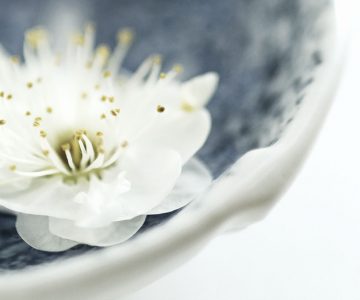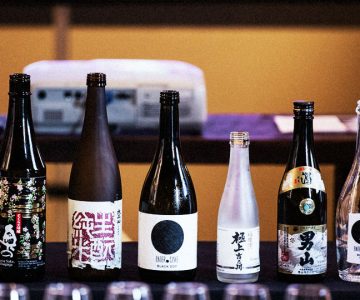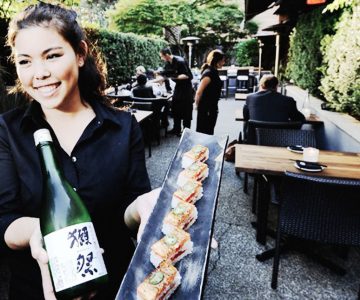Not quite an edge-of-your-seat page-turner, The Textbook of Sake Brewing by the Brewing Society of Japan nonetheless offers some rather eloquent prose: “The moisture content of steamed rice influences the ease of handling through factors such as its hardness or the ease by which the lumps of the steamed and the cooled rice can be broken up, and the growth of the Kōji fungi around the kernel or its enzyme activity,” to cite but one example. It also sports a glossary of sake brewing terms where the inquisitive can learn the meaning of such exotic terms as shinseki, hikikomi, tsubodai, dakidaru and bōshitsu, the latter being particularly noteworthy.
Bōshitsu: Accidental disappearance of finished sake.
Leave it to the Japanese to devise a term specific to the pilfering of the nation’s national drink. The midsection of that word is likely the utterance of any brewmaster upon discovering the “accidental” disappearance of his work.
It was a rather warm February afternoon on the observation deck of Tokyo’s Haneda Airport. Truth be told, the warmth was accentuated courtesy of a few rather fine shots of Japanese whisky that I had at a rather fine airport whisky bar. Lacking any other English reading material, and, frankly, lacking the energy to go looking for some, I cracked the spine of The Textbook of Sake Brewing. I almost made it through the opening paragraph before my mind started to wander, leading me to think about the circumstances surrounding the non-accidental disappearance of finished sake (a fair amount to be honest) down my throat over the past little while.
I had landed at Haneda two weeks earlier with the Lonely Planet Japan guidebook clutched in hand, the Google Translate Japan package loaded on my phone and perhaps the worst cold I’d ever had screwing with the jet-lagged mush that was, at some point in time, my brain. But whatever, I was in Japan to gain intimate knowledge of sake and I wasn’t about to let little things like crossing the International Date Line as a Type 1 diabetic with a cranium-compressing malady mess with my party. (I mention the diabetic part only to assure other diabetics that travelling through multiple time zones is no big deal … Japan was actually easier than I had anticipated. If you want tips, please email me at: [email protected])
First-timers (as I was) to Japan will find the country fascinating, perplexing and totally alien. At once a mixture of incredible precision and efficiency, it’s also frustratingly formal and awash in rules and regulations (some written; most not) and subtleties that even the most fastidious outsiders will likely miss. Depending on your particular demeanour, Japan will be totally your bag or totally not.
The language thing is definitely a thing. Your worldly friends might encouragingly say, “Oh, don’t worry, everyone there speaks English.” They don’t. Maybe in the airports, swank hotels and the downtown-iest parts of downtown Tokyo, but stray a tad off the beaten track and you’re S.O.L. (As an aside, the Google Translate Japan package really does work, and it got me out of a few uncomfortable situations.) On the upside, the Japanese are almost impossibly courteous and accommodating. They know you know you are feeling a bit, well, lost in translation.Luckily, the first half of my stay was as a guest of the Japan Sake and Schochu Makers Association (hereafter known as the JSS) with the fluent-in-English Etsuko Nakamura (a Sake Samurai — yep, that’s a real title) acting as my translator, guide and tour coordinator.
The focus of my trip was largely to be an exploration of the sakes of the Hiroshima Prefecture — and all that goes into their production and enjoyment. However, before jetting from Tokyo to Hiroshima, I was first treated to a couple of informative presentations, one from Yoshiro Okamoto of the JSS and one from John Gauntner, who is widely regarded as the world’s foremost non-Asian sake expert.
Okamoto’s presentation revealed some interesting facts: consumption of premium sake domestically is on the upswing, particularly among the young ’uns, and, next to the United States, Canada is the number one non-Asian export market.
Gauntner gave me a crash course in sake, taking me through the styles, labourious production steps and the importance of each sake component — from the polished and steamed rice, the mysterious koji that works together with specific yeast strains to create a unique “parallel fermentation” and, of course, the water used, and how fermentation is slower using soft water rather than hard.
Soft water is what you’ll typically find in the Hiroshima Prefecture. A producer of some of Japan’s most premium sake today, this wasn’t always the case. Up until about 120 years ago, the region had a less-than-great brewing reputation: its water lacked the minerals necessary to nourish fermentation. This changed when a brewer named Senzaburo Miura, from the village of Akitsu, which faces the beautiful Seto Inland Sea, mastered soft water brewing. He also created a new style of sake — ginjo — and focused national attention on the area when the sake produced here started to consistently take home top awards from the Zenkoku Shinshu Kampyou-kai, Japan’s most prestigious sake competition.
“Try a hundred things, and make a thousand improvements.” ~ Senzaburo Miura
You can see the house where Miura lived from the Imada Shuzo Sake Brewery Co., a small, family-run producer of top-quality sake established in 1868. The brewery’s white outer walls reflected the afternoon sun as I sat at a table enjoying some extremely elegant and complex Fukucho sake and scarfing down fantastic fried local oysters.
If the song of sake is to ring throughout the English-speaking world, the JSS could do worse than to recruit Miho Imada as the bandleader. Personable, passionate and photogenic, Imada not only speaks fluent English, but she’s also a woman toji or master brewer. And she owns the brewery. Though more women are working in the sake industry, it’s still pretty male dominated. Having a toji who is also a brewery owner who is also a woman is a rare circumstance.
Imada’s Fukucho brand sakes epitomize what Hiroshima is all about: aromatic, balanced, subtly complex, gently fruity, with a silky mouthfeel and a clean, lasting finish. The ingredients are basic(ish): polished, steamed rice, koji, yeast and water (okay, brewer’s alcohol too, in the case of non-junmai-grade sake). The quality of each ingredient is crucial, and how they are treated and interact is precise.
Rice is to sake as grapes are to wine — though with sake, the strain of yeast used during fermentation is a more important flavour component than the yeast used for wine. Yamadanishiki is perhaps the most popular sake rice, but other, more local varieties are also being used (Bizen-Omachi, Hattan Nishiki and Iwai being a few). Yet it’s more about how the rice is treated that reflects the pedigree of a particular bottling.
I watched clouds of vapour billowing out of rice steamers in a number of breweries. Steaming — as far as I could tell — typically takes place at an hour when most nocturnally inclined writers are still half-dead. Nonetheless, I bravely hauled myself out of bed on a daily basis to board the bus, don slippery slippers (shoe wearing being verboten in breweries) and observe the rice-steaming ritual, shivering while the early morning winter sun streamed through open windows. After the rice is washed and soaked to wash away the rice dust (I’ll talk about where that comes from in a bit), it’s steamed to soften the grains, preparing them for the infusion of koji and ensuring they break up during fermentation. The aim is to get them to a “reverse al dente” state: firm on the outside, soft on the inside.
Today’s misty observations are happening at the Fujii Shuzo Sake Brewery in the preservation district of Takehara City (aka, Little Kyoto) with its intricate latticework, heritage sites and historic residences and temples dating back to the Edo Period. The brewery itself was founded in 1863 and today remains a small, artisanal producer of exclusively junmai sake (pure rice sake with no added alcohol). The brewery’s Ryusei brand sakes are award-winning, relying on the high-quality local water and a blend of three strains of sake rice specially grown by local farmers. “Sake is not a man-made product,” says fifth-generation proprietor Yoshifumi Fuji, “but a product of nature.”
From the rice growing (more often than not by locally contracted farmers), to the polishing, washing, steaming and koji cultivation, through to the particular yeast strains, the creation of the yeast starter, the “parallel fermentation” that’s unique to sake brewing, the filtration and the final aging, making sake takes a lot of hard work. Most of the breweries I visited, including a handful of artisan producers in the town of Saijo — Hiroshima’s “sake town” where you can tour eight top-quality breweries on foot — sport little, if any, automation. Even the newer breweries, like Saijo’s Kamoizumi Shuzo (only 105 or so years old), adhere to traditional production methods even while pioneering new styles.
There’s plenty of information available that deals with the ins and outs of sake production so I will try not to belabour it here. However, it is interesting to see how many peripheral entities aid in the process. Earlier, I talked about rice dust, which is the result of the rice being polished during the initial stage of sake production. Some breweries polish their own rice while others have it polished by an outside mill.
Koji, the mould (Aspergillus oryzae) that breaks down the rice grain’s starch core, rendering it fermentable, is cultivated by outside companies, like Osaka’s Higuchi Matsunosuke Shoten Co., one of only six companies in Japan to breed the stuff.
Yeast used for fermentation is also incredibly important for developing the aromas and flavour components of sake. Ongoing research, experimentation and quality enhancement is equally important. Cultivation of the various yeast strains and their distribution is largely handled by the Brewing Society of Japan, with the experimentation, research, quality enhancement and oversight of the Annual Japan Sake Awards handled by the National Research Institute of Brewing and Sake Appraisal (NRIBS).
The JSS tour left me informed, enlightened and excited to learn even more about Japan’s national drink. And that was only the first week of my two-week stint. I spent another week on my own, continuing my (somewhat wide-eyed) explorations as I blasted from Osaka to Kyoto to Tokyo on the incredible Shinkansen “bullet” trains, collecting memories, souvenirs and unforgettable experiences, many revolving around Japan’s incredible cuisine.
An amazingly presented and paced (not to mention deliriously tasty) kaiseki lunch at Kyoto’s Seiwasou with Tsuneo Maruyama, President of the Tamanohikari Shuzo Brewery and Production Manager Matsushima Yasuyuki, and a mind-blowing omakase dinner served to me personally, piece by piece (about 24 of them as far as I could count), by Kodan (Ken) Tenmabashi, Owner and Chef of Osaka’s Omakase Kodan are but two of my countless food adventures.
Kaiseki is a stylish and stylized dining ritual that is nirvana for the type of person who appreciates subtlety, beauty, relaxation and, well, meditation when it comes to dining.
If you are a pizza and beer type, keep away. Far away.
Maruyama courteously poured more sake every time my glass was rendered half full. His glass remained empty for probably half the meal as I totally forgot the “I fill yours, you fill mine” sake-drinking etiquette (see page ???). I did mention that there were subtleties involved with kaiseki, right? As I recall, he finally resorted to pouring his own. (My apologies, Tsuneo.)
Omakase might, in the grand hierarchy of Japanese eating, be viewed as less sophisticated than kaiseki, but it’s no less delicious (and far less fussy). Born in Osaka, Tenmabashi spent a couple of years in British Columbia before returning to Osaka to open Kodan. “How adventurous are you?,” he asked, with what I took to be a “I dare you” tone of voice. “I’m not saying I’m going to like it all,” I lied knowing I probably would, “but hit me with everything you’ve got.” He did … and I did. The multi-course masterclass in gastronomic bliss was matched with a range of craft sakes and capped off by a dram of Nikka Taketsuru 17 Year Old Japanese single malt whisky. I’ve seriously contemplated flying back to Japan solely for a repeat performance.
As Air Canada Flight 006 ascended from Haneda, with the glittering night-time expanse of downtown Tokyo disappearing as the landing gear thunked snugly into the belly of the plane, I shut off the reading light, slid in the noise-cancelling earbuds and drifted off … exhausted, slightly overwhelmed and eager to return.



